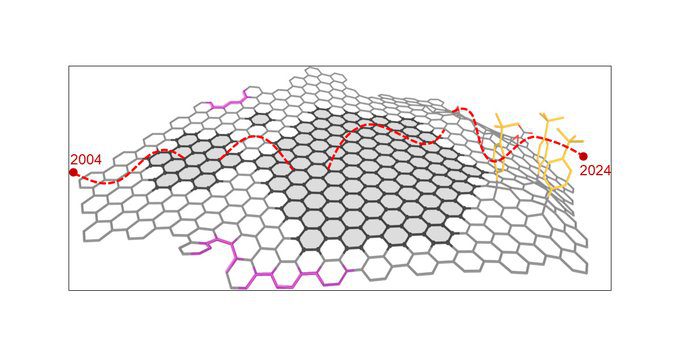The Evolution of Graphene
Graphene, a single layer of carbon atoms arranged in a two-dimensional honeycomb lattice, has been a subject of intense research and development over the past two decades. Initially discovered in its pristine form, graphene’s exceptional electrical, thermal, and mechanical properties have made it a material of great interest in various fields, including electronics, energy storage, and composite materials.
From Pristine Graphene to Chemically Engineered Nano-Sized Flakes
The journey from pristine graphene to chemically engineered nano-sized flakes has been marked by significant advancements. Researchers have developed methods to manipulate graphene’s properties through chemical modifications, enabling the creation of tailored materials for specific applications. These chemically engineered graphene flakes have opened new avenues in material science, particularly in the fields of machine learning and computational chemistry.
Breakthroughs in Material Science
One notable breakthrough in material science is the creation of a thin film with significantly increased electron mobility by scientists at the Massachusetts Institute of Technology (MIT). This innovation has the potential to revolutionize thermoelectric and spintronic applications, impacting sectors like energy and electronics. The research highlights the importance of increasing electron mobility, which could lead to more efficient energy conversion and faster information processing. For more details, refer to the MIT scientists’ breakthrough in superconductivity.
AI and Machine Learning in Material Discovery
The integration of artificial intelligence (AI) and machine learning in material discovery has accelerated the development of new materials. For instance, the French startup Altrove uses AI models and lab automation to create new materials, focusing on inorganic materials and rare earth elements. By leveraging AI, Altrove has been able to predict more stable materials in the last nine months than in the previous 49 years. This approach not only speeds up the discovery process but also enhances the accuracy of material predictions. Learn more about Altrove’s AI-driven material discovery.
Nobel Prize-Winning AI Innovations
The 2024 Nobel Prize in Chemistry was awarded to David Baker, Demis Hassabis, and John M. Jumper for their work on proteins. Hassabis and Jumper developed AlphaFold2, an AI model that predicts the three-dimensional structures of nearly all known proteins. This breakthrough has significant implications for understanding antibiotic resistance and designing enzymes for environmental sustainability. The integration of AI in scientific research is a growing trend, as highlighted by the 2024 Nobel Prize in Chemistry.
Future Prospects and Challenges
As graphene research continues to evolve, the focus is shifting towards overcoming challenges related to scalability and cost-effectiveness. The development of automated labs and high throughput methodologies, as seen with Altrove, is crucial for accelerating the feedback loop and improving material recipes. Additionally, responsible sourcing and usage of rare earth elements, along with the potential environmental impact of new materials, remain important considerations for sustainable development.
Related Articles
- AlphaFold2: The AI Revolutionizing Protein Structure Prediction
- Code of Culture: A Journey into Generative Art and Machine Learning
- Unleashing the Power of MetaGravity’s Hyperscale Engine on NVIDIA CPUs
- Revolutionizing 3D Creation with AI: From PS5 Dreams to Gaussian Splats
- Predicting Collective Dynamics of Multicellular Systems with Geometric Machine Learning
Looking for Travel Inspiration?
Explore Textify’s AI membership
Need a Chart? Explore the world’s largest Charts database
